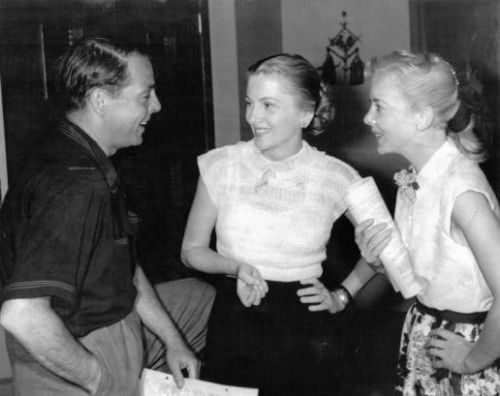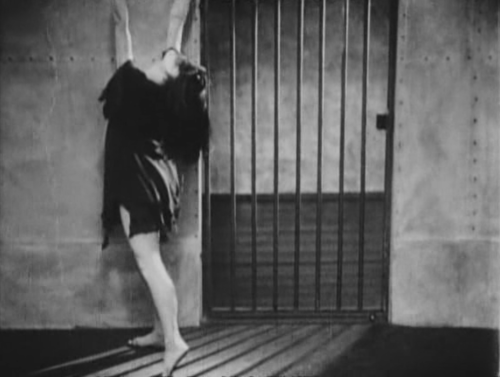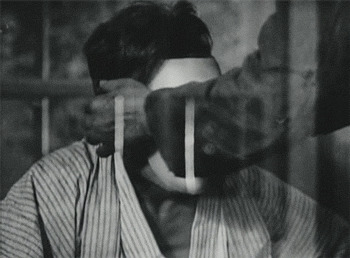Tradutor / Translator / Traductor / Übersetzer / Traduttore / Traducteur / 翻訳者 / переводчик
Friday, October 27, 2017
Uma Página de Loucura (1926) / A Page of Madness (1926)
Saturday, October 21, 2017
O Bígamo (1953) / The Bigamist (1953)
Na era clássica de Hollywood, havia poucas mulheres diretoras. Obviamente, havia algumas mulheres fazendo filmes experimentais, mas dentro dos estúdios, com acesso a um bom elenco, equipe e orçamento, havia apenas duas: Dorothy Arzner e Ida Lupino. Arzner trabalhou nos anos 30 e 40, e Lupino veio logo depois, trabalhando nos anos 50 e 60. Ida Lupino dirigiu 41 filmes e episódios de séries e TV entre 1939 e 1968. Hoje falaremos de um de seus mais conhecidos filmes, “O Bígamo”, de 1953.
In the classic Hollywood era, there were very few female directors. Sure, there were some doing experimental work, but inside the big studios, with access to a good cast, crew and budget, there were only two: Dorothy Arzner and Ida Lupino. Arzner worked in the 1930s and 40s, and Lupino came next, working in the 1950s and 60s. Lupino directed 41 movies and TV episodes between 1939 and 1968. Today we’ll talk about one of her most famous movies, 1953’s “The Bigamist”.
Harry Graham (Edmond O’Brien) e sua esposa Eve (Joan Fontaine) querem adotar uma criança. Eles vão até uma agência de adoção e preenchem a papelada. O próximo passo é uma rápida investigação sobre a vida do casal, levada a cabo pelo senhor Jordan (Edmund Gwenn). Harry se mostra relutante e desconfortável com a investigação. O casal Graham vive em San Francisco, mas Harry viaja com frequência para trabalhar em Los Angeles. O senhor Jordan segue Harry até LA, e descobre que ele tem uma segunda família, completa com um filho bebê e uma esposa, Phillys (a própria Ida Lupino).
Harry Graham (Edmond O'Brien) and his wife Eve (Joan Fontaine) want to adopt a child. They go to an adoption agency and fill in all the forms. The next step is a quick investigation about their lives, made by Mr Jordan (Edmund Gwenn). Harry is reluctant and uncomfortable about this investigation. The Grahams live in San Francisco, but Harry travels often to Los Angeles to work. Mr Jordan follows Harry until LA, and finds out he has another family there, complete with a baby son and a wife, Phyllis (Ida Lupino herself).
Depois de descobrirem que não podem ter filhos, Harry e Eve começam a trabalhar juntos na área de vendas, e ela rapidamente dobra os lucros dele. Ela fica cada vez mais interessada no trabalho. Ele fica cada vez mais frustrado com o novo interesse dela. Quando vai para Los Angeles para uma viagem entediante, ele faz um passeio de ônibus e conhece uma mulher igualmente entediada – Phyllis. Com o tempo, o relacionamento deles se desenvolve.
After finding out they couldn't have children, Harry says Eve started working with him in the sales business, and quickly doubled his sales. She becomes more and more invested in working. He becomes more and more bummed by her new interest. When he goes to a boring business trip to Los Angeles, he takes a bus tour and meets an equally bored woman – Phyllis. With time, they get involved.
Há traços do noir em “O Bígamo”? Claro. Primeiro, você tem uma história contada em flashback. E várias escolhas estilísticas são puro noir: a inclusão de lâmpadas no enquadramento e as muitas sombras que têm origens em cortinas, janelas e paredes, por exemplo. Entretanto, não é um noir, não é um drama familiar, não é de maneira alguma um romance. Mas é real, e é uma golfada de ar fresco no sistema de estúdio, que na maioria das vezes trabalhava como uma linha de produção.
Are there noirish traces in “The Bigamist”? Sure. First, you have a story told in flashback. Also, many stylistic choices scream noir: the inclusion of lamps in the frame and the many shadows cast by curtains, windows and walls, for instance. However, it's not a noir, it's not a family drama, it's not a romance at all. But it's real, and it's a blow of fresh air in the studio system, that more often than not worked like an assembly line.
Não era a primeira vez que Joan Fontaine interpretava uma personagem com problemas conjugais – quem pode se esquecer de seu trabalho em “Rebecca” (1940), como a segunda senhora De Winter? Sim, Harry até tenta confessar para Eve que a está traindo quando a traição ainda nem havia sido consumada, mas ela muda de assunto. Neste exato momento do filme, vemos como Eve é insegura. Infelizmente, Joan Fontaine não tem muito mais o que fazer a não ser mostrar algumas expressões faciais significativas perto do final.
It was not the first time Joan Fontaine played a character with marital problems – who can forget her work in “Rebecca” (1940), as the second Mrs De Winter? Sure, Harry does try to tell Eve about his cheating when it wasn't even cheating yet, but she changes the subject. In this exact moment in the film, we see how insecure Eve is. Unfortunately, Joan Fontaine doesn't have much more to do than to showcase some meaningful facial expressions near the end.
E é muito interessante saber que Ida Lupino e Joan Fontaine foram quase rivais de verdade na vida amorosa. A história não é tão surpreendente ou patética quanto a do filme: o roteirista Collier Young, sócio de Lupino na produtora independente The Filmakers, foi casado com Ida Lupino entre 1948 e 1951. Um ano depois, ele se casou com Joan Fontaine, com quem ficou até 1961. A situação não criou um clima ruim nos bastidores de “O Bígamo”, e com frequência os dois casais socializavam – Collier e Joan, Ida e seu novo marido, Howard Duff.
And it’s extra interesting to know that Ida Lupino and Joan Fontaine were almost romantic rivals in real life. The story is not nearly as salacious or pathetic as the one in the film: screenwriter Collier Young, Lupino’s partner in the independent film production company The Filmakers, was married to Ida Lupino from 1948 until 1951. The next year, he married Joan Fontaine, and the two remained together until 1961. The situation didn’t interfere with the mood during filming “The Bigamist”, and the two couples frequently had fun together – Young and Fontaine, Lupino and her new husband Howard Duff.
 |
| Collier Young, Joan Fontaine, Ida Lupino |
Esta não é uma lição de moral. “O Bígamo” não tem a intenção de ensinar algo ao espectador, nem de julgar seus personagens. Há um dilema moral, sim, mas Harry não é retratado como mulherengo e Phyllis não é retratada como destruidora de lares. E devemos isso a Ida Lupino.
This is not a cautionary tale. “The Bigamist” is not supposed to teach something to the viewer, and not even to judge its characters. There is a moral dilemma, sure, but Harry is not portrayed as a womanizer and Phyllis is not portrayed as a home wrecker. And we owe this to Ida Lupino.
Ida Lupino era uma boa diretora, mas eu bem que gostaria que ela fosse mais ousada e inovadora. Para ser aprovada pelos censores do código Hays, “O Bígamo” tinha de ser incrivelmente cuidadoso – o próprio assunto do filme era muito ousado. Por isso há muitos eufemismos para que finalmente seja revelado que Phyllis está grávida de um filho de Harry. Eu entendo completamente por que Ida teve de fazer isso.
Ida Lupino was a good director, but I wish she was more daring and groundbreaking. To be approved by the Hays Office, “The Bigamist” had to be extra cautious – the subject matter in itself was very bold. That's why there is a lot of euphemisms to finally tell that Phyllis is pregnant with Harry's child. I completely understand why Ida had to do this.
 |
| Mr Jordan (Edmund Gwenn) |
Ida Lupino era uma mulher fazendo um filme centrado num personagem masculino. Eu adoraria ver as duas esposas contando as versões delas da história, compartilhando seus pensamentos e sentimentos. Eu adoraria se Ida tivesse dado voz a estas mulheres. Eu sei que seria bem difícil, considerando a época, mas também seria incrível e histórico.
Ida Lupino was a woman directing a picture centered in a man. I'd love to see the two wives telling their versions of the story, sharing with us their thoughts and feelings. I'd love if Ida had given those women a voice. I know it'd be quite hard for the time period, but it'd also be amazing and historic.
Infelizmente, mesmo tendo Ida Lupino muito jeito para aos negócios, “O Bígamo” não foi um sucesso de bilheteria. Ida Lupino e Collier Young decidiram distribuir o filme de maneira independente, o que certamente afetou a performance na bilheteria. Ida Lupino se dedicou à televisão, e só voltaria a dirigir outro filme 13 anos depois. Isso é uma pensa, porque “O Bígamo” é um filme interessante – e, se no final nós não nos importamos com o destino de Harry e suas duas esposas, isso é um trunfo de Ida Lupino e seu gosto por histórias diferentes.
Unfortunately, even with Lupino’s great brains for business, “The Bigamist” didn’t do well at the box office. Lupino and Young had decided to distribute the picture in an independent way, and it certainly hurt the performance. Ida Lupino started directing more television, and only directed another movie 13 years later. This is too bad, because “The Bigamist” is an interesting flick – and, after all, if by the end we don’t really care about which wife wants Harry back, it’s because of Ida Lupino’s taste for unique stories.
This is my contribution to the Joan Fontaine Centenary blogathon hosted by Virginie at The Wonderful World of Cinema and Crystal at In the Good Old Days of Classic Hollywood.


+hall.png)
%2B1.png)








